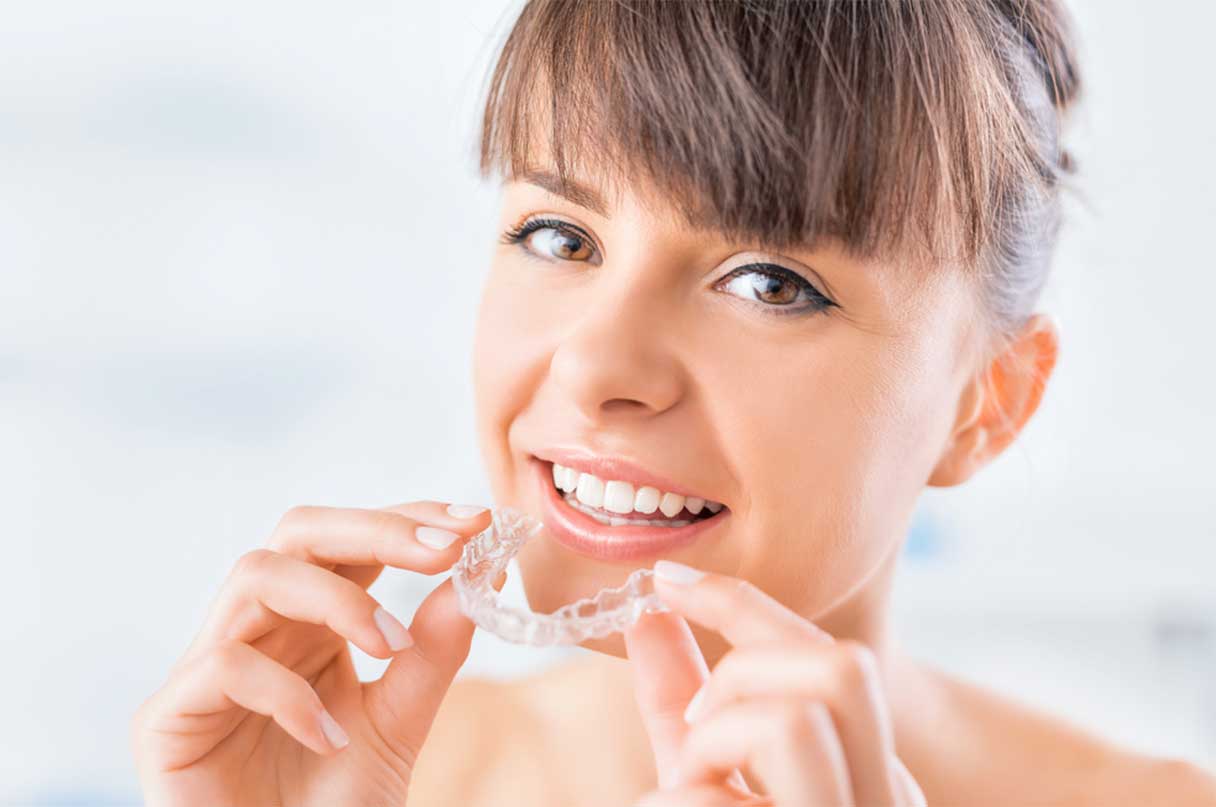If you’ve got a crooked smile or other alignment problem, clear aligners are a virtually invisible option for straightening teeth. For many, they are more convenient and comfortable than traditional metal braces. "Clear aligners" is the generic term; most people have heard of Invisalign®, which is the largest brand of clear aligners used to straighten teeth.
Besides making people self-conscious about their smile, crooked or crowded teeth can also affect dental hygiene and lead to oral health problems, including tooth decay and gum disease.1
Kids, teens and adults can use clear aligners to fix issues like overbite, underbite and crowding, to name a few. Treatment is usually faster and involves fewer trips to the dentist, and the aligners can be taken out for eating, drinking and even special occasions.1
What Are Clear Aligners?
Clear aligners are an orthodontic treatment that uses a series of removable clear dental appliances to gradually straighten your teeth.1 The clear aligners are custom-made, based on a 3D scan of your teeth, and then trimmed down for comfort.2 The treatment process involves swapping out aligners every week or so to keep shifting your teeth until they’re in the intended position.1
Clear aligners can be used to fix different alignment issues in children, teens and adults, including:1
- Crossbite
- Crowded teeth
- Gaps
- Open bite
- Overbite
- Slightly crooked teeth
- Underbite
How Much Do Clear Aligners Cost?
The national average cost* of clear aligners without insurance in the United States is $5,108. This cost can vary between $1,800 and $8,100, depending on where you are in the U.S.3
Other factors that can impact the price you pay for clear aligners include the type of braces, length of treatment, age of the patient and more.3
The cost of clear aligners is about the same as braces. Your dentist will determine how much you’ll pay for treatment based on the complexity of your needs and how many aligners you’ll need.
Average cost of clear aligners by state/district
Here are the average costs*, excluding any potential insurance coverage you may have, for all 50 states and the District of Columbia:3
| State/District | Average cost |
|---|---|
| Alabama | $4,751 |
| Alaska | $4,878 |
| Arizona | $4,796 |
| Arkansas | $5,250 |
| California | $5,399 |
| Colorado | $5,870 |
| Connecticut | $5,019 |
| Delaware | $5,447 |
| District of Columbia | $5,337 |
| Florida | $5,577 |
| Georgia | $4,651 |
| Hawaii | $6,192 |
| Idaho | $5,538 |
| Illinois | $5,238 |
| Indiana | $5,070 |
| Iowa | $4,861 |
| Kansas | $5,071 |
| Kentucky | $5,253 |
| Louisiana | $4,822 |
| Maine | $5,453 |
| Maryland | $5,839 |
| Massachusetts | $4,494 |
| Michigan | $4,342 |
| Minnesota | $5,274 |
| Mississippi | $5,658 |
| Missouri | $4,966 |
| Montana | $4,024 |
| Nebraska | $5,721 |
| Nevada | $4,938 |
| New Hampshire | $4,868 |
| New Jersey | $4,661 |
| New Mexico | $5,934 |
| New York | $6,177 |
| North Carolina | $5,452 |
| North Dakota | $4,118 |
| Ohio | $4,044 |
| Oklahoma | $4,606 |
| Oregon | $5,290 |
| Pennsylvania | $3,800 |
| Rhode Island | $6,516 |
| South Carolina | $6,084 |
| South Dakota | $5,996 |
| Tennessee | $5,409 |
| Texas | $3,967 |
| Utah | $3,668 |
| Vermont | $5,076 |
| Virginia | $4,837 |
| Washington | $5,412 |
| West Virginia | $4,259 |
| Wisconsin | $5,655 |
| Wyoming | $5,722 |
Does Insurance Cover Clear Aligners?
Many insurance plans cover clear aligners, just as they do traditional braces. Depending on your plan, insurance may cover up to $3,000 for orthodontic treatment. Some dentists offer payment plans to help you pay for treatment over time. You can also use your health savings account (HSA) or flexible spending account (FSA) to help cover the cost of clear aligners.4
If dental insurance isn’t an option, the CareCredit credit card, which many Invisalign dentists accept, may be another way to pay for copays, deductibles or other out-of-pocket costs.
Benefits of Clear Aligners
Clear aligners have become a popular alternative to traditional metal braces for a few reasons. Below are some of the key benefits:4
- Once on your teeth, clear aligners are practically invisible.
- Treatment is faster — often five months faster, on average — than braces.
- They require fewer visits to the dentist’s office.
- Clear aligners are often more comfortable and less painful than braces.
- You can remove the aligners for special occasions, to eat and drink and to brush and floss.
Are Clear Aligners Right for You?
Clear aligners offer treatment solutions for individuals across various age groups, including teenagers, adults and even children. For instance, Invisalign First™ is a treatment specially designed for children ages 6 to 10.5
While clear aligners can be used to treat a wide range of minor to complex alignment issues, they may not be right for everyone. For instance, people with oral health issues, like cavities or gum disease, will need treatment before starting with clear aligners. Also, certain severe alignment issues can only be treated by orthodontic surgery.6
People with dental bridges are also not typically candidates for clear aligners because the aligners are designed to move teeth individually, and bridgework connects two or more teeth together.6
Your dentist can determine if clear aligners are right for you.
How Clear Aligners Work
Here’s an overview of how clear aligner treatment works, from the start to your new smile.
Consultation
Treatment begins with a consultation with a dentist or orthodontist who is trained in working with clear aligners or Invisalign. The dentist will examine your teeth and use the iTero Element™ scanner to create a detailed, 3D scan of your smile. The scan is used to map out your custom treatment plan and shows what to expect at every stage of your treatment. You can even get a preview of what your new smile could look like.2
Procedure
Depending on the complexity of your case, your dentist may apply special attachments to your teeth to help move them into place. SmartForce™ attachments are discreet, tooth-colored, tiny bumps that are placed directly on one or more of your teeth using a special bonding paste. The attachments allow your dentist to apply some extra force, where needed, to move your teeth.7
When your first set of clear aligners is ready, your dentist will check to ensure they fit correctly and are comfortable. They will schedule a series of in-person appointments for you to pick up each new batch of aligners and check your progress.2
Post-treatment
Clear aligners need to be worn for at least 20 to 22 hours per day.4 You should remove them to eat and drink and to brush and floss.4 Always put your aligners in their case when you’re not wearing them.
Depending on your dentist’s instructions, you will need to change your aligners every one to two weeks.4 Adhering to your treatment plan as directed is important for best results.
As with braces, you’ll need to wear a retainer to help maintain your new straight smile after you finish your clear aligner treatment. Some dentists offer custom-made Vivera™ retainers that are made with the same technology as your Invisalign aligners. Depending on your dentist, you may receive these or another type of retainer.2
Are Clear Aligners Safe?
Clear aligners are typically considered safe and have been FDA-approved since 1998. Clear aligners and retainers are crafted from SmartTrack material, which is made from medical-grade thermoplastic polymers that are BPA-free and have been found safe for use in the mouth.4
Like with any dental appliance, you may experience some side effects from clear aligners. Potential side effects include:4
- Temporary discomfort. Since the aligners are designed to move your teeth, you are likely to experience some temporary discomfort in the first few days of wearing a new set of aligners. Most people describe it as a pressure-type sensation.
- Speech changes. You may notice that talking feels strange at first and that you have a lisp. This should improve in a few days once your tongue gets used to the aligners.
- Teeth feeling loose. Your teeth might feel loose when you remove your aligners. This is normal and happens because your teeth are moving into their proper position and the gums around the teeth are adjusting.
If you have concerns, contact the provider of your clear aligners.
Tips to Protect Your Clear Aligners
There are things you need to do to help protect your clear aligners and keep them — and your teeth — clean, healthy and strong throughout your treatment:8
- Brush and floss after eating. Clear aligners are removable and should be taken out when you eat, so no dietary restrictions are necessary. However, you do need to brush and floss your teeth after every meal before putting your aligners back on to maintain good oral health and prevent staining them.
- Don’t chew gum while wearing your aligners. Gum can stick to your aligners and damage them. If you want to chew gum, remove your aligners first.4
- Be mindful. Clear aligners are made to be durable and only worn for one to two weeks at a time, but they can crack. If that happens, call your dentist or orthodontist immediately.
- Case them when not in use. Store your clear aligners in a protective case when they aren't in your mouth. This prevents them from getting lost or dirty.
- Don’t smoke. Smoking will stain your aligners, so it’s advisable to avoid smoking during your aligner treatment.4
- Clean your aligners. Use a soft-bristled toothbrush and a small amount of toothpaste to clean your aligners inside and out. Soaking them in Invisalign Cleaning Crystals will help keep them clean and clear.
- Practice good oral hygiene. Good oral hygiene habits will keep your teeth and gums healthy during and after clear aligner treatment. In addition to brushing and flossing, be sure to get regular dental exams and cleanings.
- Wear your retainer after treatment. Wearing a retainer after orthodontic treatment is almost always recommended, whether you have braces or clear aligners. If your dentist prescribes a retainer, use it as directed to help maintain your new, straight smile.4
The Bottom Line
Clear aligners have revolutionized the way people achieve straighter teeth. They offer a less invasive alternative to traditional braces and effectively treat a variety of dental issues, making them a popular choice for teens and adults with mild to moderate correction needs.
Clear aligners can have potential complications, such as discomfort or difficulty achieving desired results, so it’s important to follow your dentist’s guidance closely. While the process involves a commitment to wearing the aligners consistently, the benefits of improved oral health and a confident smile may make it a worthwhile investment.
Frequently Asked Questions About Clear Aligners
Do you have more questions about clear aligners and Invisalign? Here are answers to some commonly asked questions.
CareCredit Credit Card Financing for Clear Aligners
Whether you're investing in clear aligners or you're simply paying for a dental exam, the CareCredit credit card can help you pay for costs not covered by insurance.** Use our Acceptance Locator to find a dentist or orthodontist near you that accepts CareCredit to help get you on track to your perfect smile. Continue your wellness journey by downloading the CareCredit Mobile App to manage your CareCredit account, find a provider on the go and easily access the Well U blog for more great articles, podcasts and videos.
In addition to orthodontics, you can also use your CareCredit credit card for pet care, cosmetic, vision, hearing, health systems, dermatology, pharmacy purchases, spa treatments and so much more within the CareCredit network. How will you invest in your health and wellness next?
Author Bio
Adrienne Santos-Longhurst is a writer who has been covering health and lifestyle for almost two decades. Her work has appeared in Healthline, Insider, Medical News Today and more.









